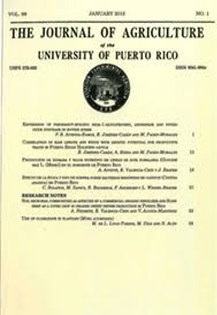Abstract
Tahiti' lime, Citrus latifoliaTanaka grafted onto five citrus rootstocks: 'Swingle citrumelo' [Citrus paradisiMacf. x Ponsirus trifoliata (L.) Raf.], 'Carrizo' [C. sinensis x P. Trifoliata (L.) Raf.], 'HRS 812' [tangerine 'Sunki', C. reticulata x P. trifoliate (L.) Raf.], 'Rough lemon' [C. jambhiri] and 'Cleopatra' mandarin [Citrus reshni Hort. Ex Tan.] was evaluated at the Isabela and Corozal Substations, Puerto Rico. The parameters tree height, canopy diameter, canopy volume, efficiency, number and weight of fruits per tree, percentage of juice, total soluble solids, total soluble solids/acid ratio and efficiency were evaluated. The highest yield at Isabela was obtained on the rootstocks 'Rough lemon' and 'Swingle' with 42.7 and 35.9 kilograms of fruits, respectively. These values did not differ significantly from the yields obtained on the rootstocks 'HRS 812' (23.6 kg) and 'Cleopatra' (28.7 kg); however, they significantly exceeded the yield of 'Carrizo' rootstock (21.6 kg). At Corozal, the highest yields were recorded in the rootstocks 'Rough Lemon' (52.9 kg), 'HRS 812' (52.7 kg), and 'Swingle' (47.6 kg), which did not differ from that of 'Carrizo' (40.9 kg) but were significantly higher than that of 'Cleopatra'. At both locations, the parameters that define the quality of fruit were acceptable and very similar. In Isabela, Candidatus Liberibacter asiaticus, the bacteria associated with the disease known as "Huanglongbing" (HLB), was detected two years after the trees were planted. However, the trees continued producing fruits and there was no decline associated with the disease. After detecting the disease in this location we used an aggressive nutritional program which included foliar and soil fertilization.

